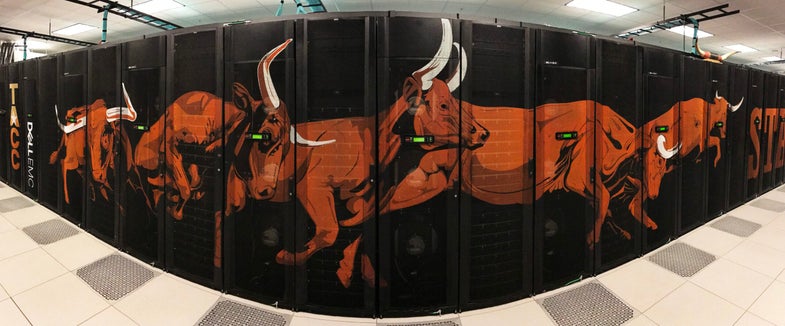University supercomputers are science’s unsung heroes, and Texas will get the fastest yet
The machine is called Frontera.

Supercomputers are powerful machines with great names—Blue Waters, Bridges, Jetstream, Comet. But a new one will soon be joining that list: Frontera. The $60 million machine will live at the University of Texas at Austin and is scheduled to come online next year.
“It will be the fastest machine ever deployed at a university in the US,” says Dan Stanzione, the executive director of the Texas Advanced Computing Center.
With supercomputers, the title of fastest is a moving target—what’s perhaps more important is not the exact ranking, but that they’re available for researchers to use in the first place. Right now, the fastest supercomputer in the world is called Summit, and it’s at the Oak Ridge National Laboratory in Tennessee, part of the Department of Energy (DOE), and is specifically tailored for AI. But supercomputers located not at government labs but at universities—like Frontera and its ilk—play a crucial role in the everyday research that scientists do.
Frontera will be “requestable by anybody doing unclassified research,” Stanzione says.
Supercomputers excell at crunching tons of data, like running simulations. For example, the kinds of problems Frontera could tackle include studying the Earth’s mantle and continental drift, Stanzione says. That’s not something you can do on an ordinary desktop. “You need to model, at a very fine scale, the entire inside of the Earth,” he says. “You just need a massive machine.”
But before researchers can start using a supercomputer, they need to get access to them in the first place; academic supercomputers give them an option beyond the DOE ones. An organization called XSEDE is key in that process, handling requests for machines like Bridges, at Pittsburgh Supercomputer Center, and Comet, at San Diego Supercomputing Center. Stanzione says that each quarter they get around four to five times the number of requests as they can meet. “It really gates progress,” he says.
“There’s so much demand for it,” Stanzione says. “The DOE systems alone don’t begin to meet it.”
With the Bridges computer in Pittsburgh, some 7,500 people are currently using it for about 1,600 projects, according to Nick Nystrom, the interim director of the Pittsburgh Supercomputing Center. “Many of them have never used a high performance computer before, and they’re just getting science done,” Nystrom says. He says their system serves non-traditional users—people who may not be the type you’d imagine want to use a supercomputer. “We have people from the Federal Reserve banks who are doing very interesting modeling of how optimally to think about setting the interest rate,” he says.
Meanwhile, the supercomputers run by the Department of Energy are accessible through a program called INCITE. “It really is only for the biggest users,” Nystrom says. Bridges is for smaller projects that use pieces of the machine. “Typically we have hundreds of jobs running at once.”
Another powerful university machine is called Blue Waters, at the University of Illinois. It has been used to do things like model an enorous, EF-5 tornado and to produce maps of Alaska. “The machines are all over subscribed,” says Bill Gropp, the director of the National Center for Supercomputing Applications at the University of Illinois. “Every one of these allocations processes leaves unhappy people.”
At the Texas Advanced Computing Center, the new Frontera machine will take up about 4,000 square feet, says Stanzione, and will operate near another supercomputer called Stampede2, which will continue to run. Kelly Gaither, an associate professor in the department of women’s health at the medical school at the University of Texas at Austin, is using Stampede2 and machine learning to study the intersection of maternal morbidity and unplanned cesarean sections. She says they’ll continue that work on Frontera.
Stanzione says that while specific subfields of science need equipment like radio telescopes, MRI machines, and electron microscopes, large computers span multiple fields. “Computing is kind of the universal instrument,” he says.
Note: This article has been updated to correct a spelling error with the XSEDE acronym.
